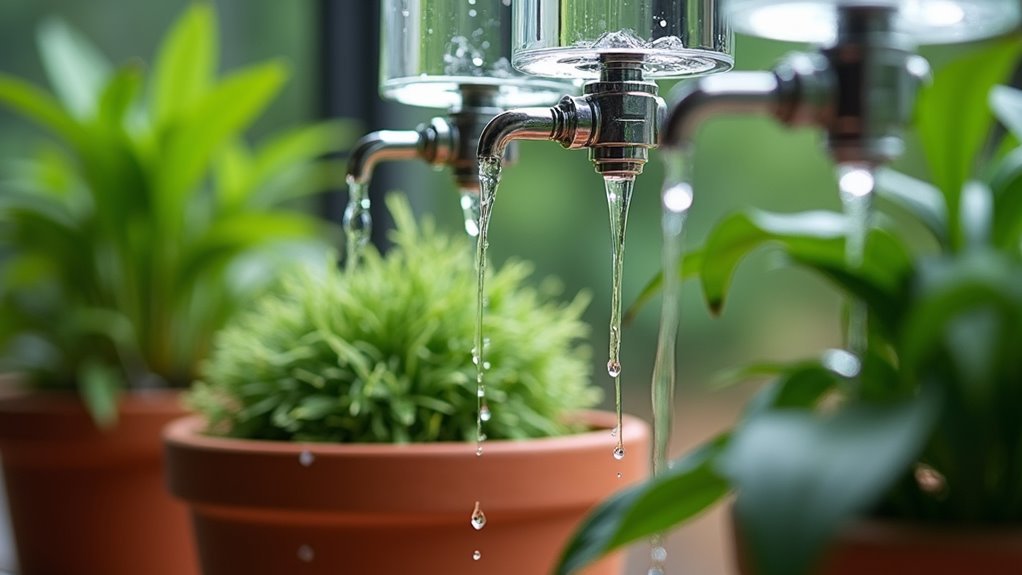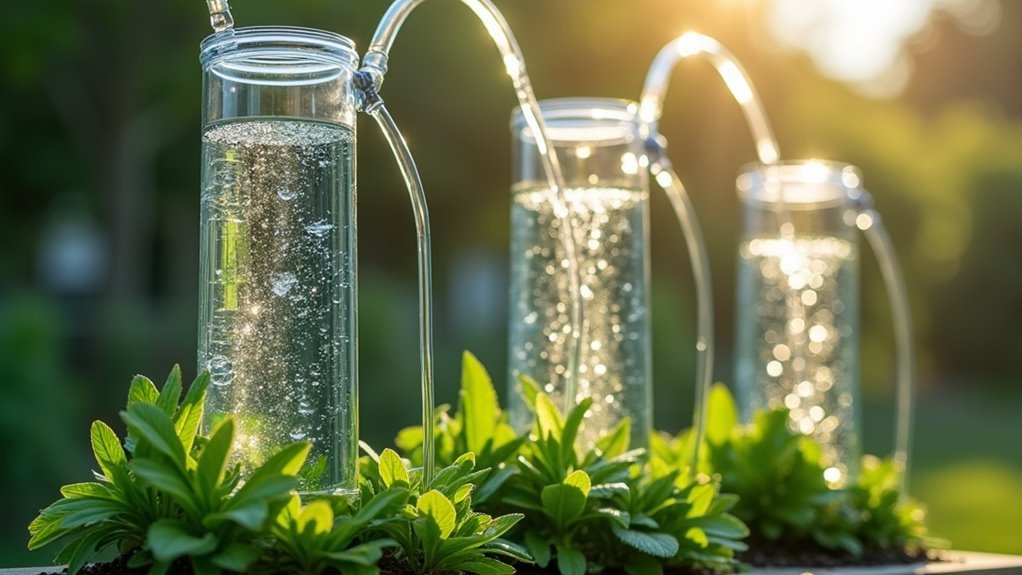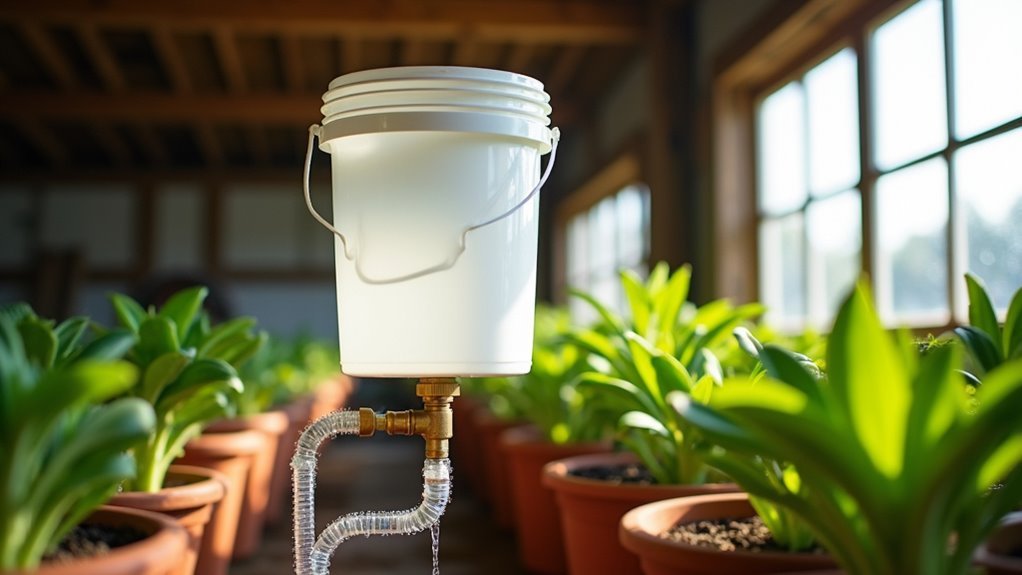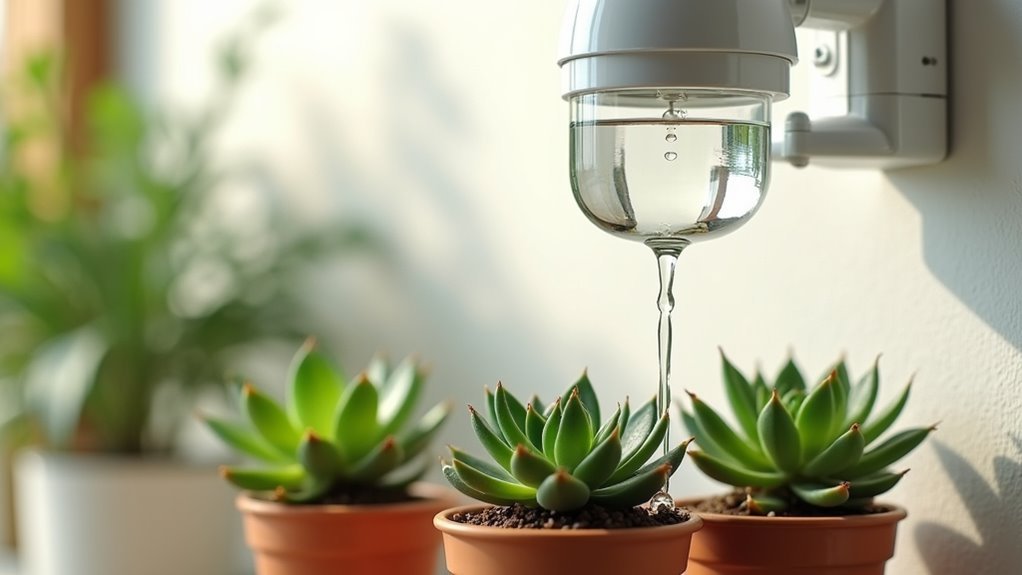You’ve probably struggled with keeping your plants consistently watered, especially when you’re away or have a busy schedule. Traditional watering methods often lead to either drought-stressed or waterlogged plants, but gravity-fed smart systems offer a surprisingly elegant solution. By harnessing the simple physics of elevated water reservoirs, you can create an automated irrigation setup that delivers precise moisture levels without electricity or complex pumps. The question isn’t whether it works, but how to optimize it for your specific needs.
Understanding How Gravity-Fed Watering Systems Function

When you’re looking for an efficient watering solution that doesn’t rely on electricity, gravity-fed systems offer a brilliantly simple approach that harnesses one of nature’s most reliable forces.
Your elevated water reservoir creates the essential water pressure needed for distribution. For every 2.31 feet of height, you’ll generate approximately 1 PSI of pressure, which effectively pushes water through supply lines to your plants.
This gravity fed system works seamlessly with drip irrigation system components, delivering water directly to root zones through emitters. The built-in wick lines allow your plants to absorb only what they need, preventing over-watering and under-watering issues.
Plants receive precisely the water they need through targeted root zone delivery, eliminating common watering mistakes.
You’ll find this method incredibly versatile, working perfectly for home gardens or off-grid applications.
Key Benefits of Gravity-Based Irrigation
You’ll find that gravity-fed irrigation systems offer three major advantages that make them incredibly practical for any gardener.
First, they don’t require electricity or pumps, making them perfect for off-grid locations and reducing your energy costs.
Additionally, they provide consistent moisture control while greatly reducing water waste compared to traditional watering methods.
No Electricity Required
Since gravity-fed irrigation systems harness the natural force of gravity, they eliminate your dependency on electrical power while delivering water directly to your plants’ root zones.
You’ll never worry about power outages interrupting your watering schedule or finding electrical outlets near your garden setup. The water flow operates continuously without pumps or motors, making these systems completely silent and energy-efficient.
Unlike traditional electric systems that connect to garden hose spigots with powered components, gravity-fed designs work anywhere you can position an elevated reservoir.
You can set them up in remote locations, greenhouses without electricity, or during camping trips. This independence from electrical infrastructure makes gravity-fed irrigation incredibly reliable and cost-effective for long-term plant care.
Consistent Moisture Control
Gravity-fed irrigation systems excel at maintaining ideal soil moisture because they deliver water at a steady, controlled rate that matches your plants’ natural absorption patterns.
The Spider Farmer 2025 uses gravity to create consistent moisture control through specialized wick lines that let plants absorb only what they need. This prevents the common problems of over-watering and under-watering that plague traditional methods.
You’ll find the system naturally regulates water flow, ensuring each plant receives enough water without excess.
The wick technology responds to soil dryness, automatically increasing flow when moisture drops and reducing it when adequate levels return. This self-regulating feature maintains optimal root zone conditions continuously, promoting healthier plant growth and eliminating guesswork from your watering routine.
Reduced Water Waste
While traditional sprinkler systems waste up to 50% of water through runoff and evaporation, gravity-fed irrigation delivers water directly to your plants’ root zones with minimal loss.
You’ll conserve significant water resources since wick lines allow plants to absorb only what they need, preventing over-watering and under-watering.
Make sure to screw together your reservoir connections properly – a single 13-gallon tank provides two weeks of automatic watering with precise control.
This Home Improvement approach eliminates the high-pressure waste common in traditional methods. Your system prevents runoff and evaporation losses while maintaining ideal moisture levels.
Regular maintenance checks for kinks and line flushing enhance efficiency, ensuring minimal water wastage throughout operation and maximizing your conservation efforts.
Essential Components for Your Watering System
You’ll need two critical components to build an effective gravity-fed watering system for your plants.
Your reservoir and tank setup forms the foundation, with a 13-gallon tank providing up to two weeks of automated watering during your absences.
The drip lines and emitters then distribute water precisely to each plant, ensuring consistent moisture delivery without waste.
Reservoir and Tank Setup
One critical component forms the heart of any gravity-fed watering system: the reservoir.
You’ll need a 13-gallon tank positioned above your plants to harness gravitational force for consistent water delivery. The height matters greatly—every 2.31 feet of elevation generates 1 PSI of pressure, ensuring proper flow to your plants.
Choose an open-bottom bucket or tank for easy access to water lines during maintenance and adjustments.
Install a shut-off valve at the reservoir’s base to control flow rates and manage your watering schedule effectively.
You must regularly inspect the tubing connected to your reservoir for kinks or damage.
These issues compromise performance and waste water, undermining your system’s efficiency and reliability.
Drip Lines and Emitters
With your reservoir properly positioned and pressurized, the water must reach your plants through a carefully designed distribution network.
Drip lines and emitters serve as your system’s delivery mechanism, transporting water directly to plant root zones while minimizing waste.
Choose non-pressure compensating emitters for your gravity-fed setup, as they’re specifically designed for low-pressure systems and maintain consistent flow rates.
For longer plant rows, drip tape provides efficient coverage, while individual shutoff valves give you precise control over specific areas.
Match your emitter selection to your system’s pressure specifications to prevent clogging and optimize performance.
Regular maintenance keeps everything running smoothly—check for kinks in your lines and flush them periodically to guarantee your drip system delivers water effectively throughout the growing season.
Choosing the Right Water Reservoir Size

Three key factors determine the perfect water reservoir size for your smart watering system: the number of plants you’re watering, their individual size, and how often you want to refill the tank.
For small indoor plants, a 5-gallon bucket will work well, while larger plants or multiple pots need a 13-gallon reservoir or bigger. A 13-gallon tank typically provides two weeks of automatic watering for ideal plant health.
Don’t forget elevation matters too. Position your reservoir higher to increase water pressure—you’ll gain 1 PSI for every 2.31 feet of elevation, improving water distribution efficiency.
Always monitor water levels regularly, especially during hot months when your plants drink more. This prevents your system from running dry when your plants need hydration most.
Calculating Proper Tank Height and Water Pressure
You’ll need to calculate your tank’s height based on the water pressure your plants require, since elevation directly controls system pressure at roughly 2.31 feet per PSI.
Your tank size must balance both water capacity and the height needed to generate sufficient pressure for your specific irrigation setup.
You should regularly test your system’s pressure to verify it’s compatible with your drip lines and emitters for peak performance.
Height Determines System Pressure
One fundamental principle governs gravity-fed watering systems: height directly translates to water pressure.
You’ll gain approximately 1 PSI for every 2.31 feet of elevation, making this calculation essential for system design. For instance, positioning your tank 10 feet above ground level generates roughly 4.3 PSI of pressure.
You must guarantee your tank sits higher than the plants it’ll serve to maintain consistent water flow. Without adequate height, your system won’t deliver water effectively to your plants.
Before finalizing your setup, check the pressure requirements of your chosen emitters. This prevents inefficient watering and guarantees peak performance.
When designing your system, calculate tank height based on your expected water usage while maintaining sufficient pressure for reliable irrigation throughout your garden.
Tank Sizing Requirements
Beyond pressure calculations, proper tank sizing requires balancing water capacity with your garden’s specific demands.
You’ll need to assess how many plants you’re watering and their individual moisture requirements to determine the ideal tank size.
Consider these essential sizing factors:
- Plant count and water needs – Calculate total daily water consumption across all plants
- Irrigation duration goals – A 13-gallon tank typically supports 2 weeks of automatic watering
- System pressure requirements – Guarantee adequate flow rate for your distribution network
- Physical space constraints – Balance tank size with available installation area
Your tank must hold sufficient water for your desired watering interval while maintaining proper pressure throughout the irrigation cycle.
Larger tanks provide extended watering periods but require more elevation space and structural support.
Pressure Testing Methods
Three critical measurements determine whether your gravity-fed irrigation system will deliver consistent water flow: tank height, generated pressure, and system compatibility.
Start by measuring your tank’s elevation above your furthest emitter. Every 2.31 feet of height generates approximately 1 PSI of water pressure. Calculate whether this pressure meets your drip lines’ minimum requirements.
Install pressure gauges at multiple points throughout your system. Test pressure at the tank outlet, midway through your main line, and at your furthest emitters.
You’ll quickly identify pressure drops caused by elevation changes, pipe friction, or blockages.
Record these measurements during initial setup and monthly thereafter. Compare readings against your emitters’ specifications to guarantee ideal flow rates.
If pressure’s insufficient, you’ll need to raise your tank height or upgrade to larger diameter pipes.
Selecting Emitters and Drip Lines for Optimal Performance
When selecting emitters for your gravity-fed watering system, you’ll need to choose non-pressure compensating options like Take-Apart emitters that work effectively under low pressure conditions of 1 PSI or less.
For different garden setups, consider these options:
- Drip tape – Perfect for longer rows in low-pressure applications
- ¼ inch soaker drip lines – Ideal for smaller areas requiring efficient water distribution
- High flow drip tape – Suitable for larger systems when paired with individual shutoffs
- Take-Apart emitters – Reliable choice for consistent performance under gravity pressure
You’ll want to verify your emitter’s pressure range matches your system’s specifications.
Include individual shutoffs when using high flow options to manage water delivery to specific plants or sections.
Regular maintenance remains essential – check for clogs and leaks consistently to maintain peak performance and reliable watering.
Installing Your DIY 5-Gallon Bucket System

You’ll start by drilling a precise 1-inch hole near your bucket’s edge and installing a brass garden hose fitting with an O-ring to create your water outlet.
Next, you’ll need to elevate your bucket using a pulley system or water tower to guarantee proper gravity-fed flow throughout your irrigation lines.
Once everything’s connected and positioned, you’ll test the system for leaks and adjust the flow rate to match your plants’ watering needs.
Drilling and Fitting Installation
Before you can enjoy automated watering, you’ll need to create the main component of your irrigation system by drilling and installing fittings in your 5-gallon bucket.
Start by using a spade bit to drill a 1-inch hole near the bucket’s edge, positioning it for ideal water flow.
Next, you’ll install the connection components:
- Insert a brass garden hose fitting into the drilled hole
- Add a garden hose O-ring to create a watertight seal
- Connect a tapered fitting from the garden hose to ¼ inch drip irrigation tube
Test for leaks by filling the bucket with 6 inches of water.
Check around the fitting for any dripping.
Once you’ve confirmed everything’s secure, you can proceed with elevating your bucket using a pulley system to maintain proper water pressure.
Elevation and Testing Setup
With your bucket properly fitted and leak-tested, the next step involves creating the elevation needed for gravity-fed water delivery.
Position your 5-gallon bucket higher than your plant root zones using a pulley system or custom structure. This elevation difference allows gravity to naturally push water through your irrigation lines.
Connect your garden hose to the brass fitting, then attach the ¼ inch drip irrigation tube to deliver water directly to plant areas.
Fill the bucket with at least 6 inches of water and test the entire setup for leaks. Check all connections carefully for dripping or water loss.
Finally, adjust your shut-off valve to control the drip rate. This guarantees your plants receive consistent watering without flooding or under-watering issues.
Building a Custom Water Tower Structure
Creating your own water tower structure transforms a simple 5-gallon bucket into an efficient gravity-fed irrigation system that’ll keep your plants consistently hydrated.
A simple 5-gallon bucket becomes a powerful gravity-fed irrigation system with the right modifications and setup.
You’ll need to modify the bucket by creating an open bottom for easy irrigation line access while keeping the lid intact to maintain water cleanliness and temperature.
Essential components for your custom tower include:
- Elevation system – Use pulleys or sturdy structures to position your bucket at ideal height
- Flow control valve – Install a shut-off valve to adjust drip rates based on plant requirements
- Enhanced drippers – Add half-gallon per hour drippers along your irrigation line for targeted watering
- Detailed planning – Create AutoCAD blueprints with step-by-step construction instructions and plumbing specifications
This setup guarantees consistent, controlled water delivery to your plants.
Setting Up Wick Lines and Distribution Networks
Four key components make up an effective wick line distribution network that’ll deliver precise moisture to each plant in your gravity-fed system. You’ll need to position your wick lines strategically, ensuring they’re fully submerged in the reservoir water for consistent delivery.
| Component | Setup Requirement | Maintenance Need |
|---|---|---|
| Wick Position | Fully submerged in reservoir | Check for proper contact |
| Line Placement | Strategic positioning per plant | Inspect for kinks regularly |
| Pot Compatibility | Adjustable for various sizes | Monitor soil connection |
The Spider Farmer system’s adjustable positions accommodate different pot sizes, making your setup versatile. Gravity creates the pressure needed for effective water flow, preventing over or under-watering. You’ll need to maintain these lines regularly by checking for blockages and ensuring they remain in contact with soil.
Adding Digital Timers for Automated Scheduling
Once you’ve established your wick line network, digital timers transform your gravity-fed system into a fully automated watering solution.
You’ll gain precise control over watering schedules without constant manual intervention. Programming your timer for specific durations, like 22 minutes daily, guarantees consistent hydration tailored to your plants’ needs.
You can schedule watering during ideal times, typically early morning or evening, to minimize evaporation and maximize water efficiency.
Key benefits of adding digital timers include:
- Reliable scheduling that maintains plant health during your absence
- Easy adjustments for seasonal changes and varying plant requirements
- Precise timing that prevents over or under-watering
- Energy efficiency by avoiding peak sunlight watering periods
This automation creates ideal growing conditions while reducing your daily maintenance responsibilities.
Incorporating Fertilizer Into Your Watering System
While your automated watering system delivers consistent hydration, adding liquid fertilizer to your 13-gallon reservoir transforms it into a complete nutrient delivery network.
You’ll achieve optimal plant health by mixing plant food directly into your water supply, ensuring consistent nutrient delivery with every watering cycle.
Choose fertilizers that are compatible with drip irrigation systems to prevent emitter and line clogging.
This compatibility keeps your system running smoothly while delivering essential nutrients to your plants.
Regular maintenance is essential for long-term success.
Flush your lines periodically to prevent fertilizer build-up that can compromise system performance.
Your digital irrigation timer can accommodate both watering and fertilizing schedules, creating an efficient, automated plant care solution that maximizes growth while minimizing your daily involvement.
Troubleshooting Common System Issues
Even the most well-designed automated watering systems can develop problems that reduce their effectiveness.
Well-designed systems require proactive maintenance to prevent performance issues that compromise plant health and irrigation efficiency.
When your gravity-fed system isn’t performing at its best, systematic troubleshooting will help you identify and resolve issues quickly.
Start by examining these common problem areas:
- Check tubing for kinks or blockages – These disruptions prevent proper water flow and compromise system performance.
- Inspect emitters for clogs or damage – Verify they’re compatible with your system’s pressure for efficient watering.
- Flush lines periodically – This prevents fertilizer build-up that reduces water delivery and affects plant health.
- Verify water source elevation – A drop in tank height decreases pressure, affecting consistent water delivery.
Conduct routine maintenance checks to identify faulty components early.
Regular repairs guarantee long-lasting functionality and superior irrigation performance for your plants.
Regular Maintenance and System Optimization
Since your gravity-fed watering system requires consistent upkeep to function at peak efficiency, establishing a regular maintenance schedule will maximize its lifespan and performance.
Start by checking tubing and emitters weekly for kinks or damage that could disrupt water flow. Flush your lines monthly to prevent fertilizer build-up from clogging emitters and reducing watering effectiveness.
Monitor drip rates regularly and adjust the shut-off valve when plant needs or weather conditions change. Inspect all components for signs of wear and repair faulty parts immediately to avoid system failures.
Keep your reservoir clean and covered to prevent contamination while maintaining cooler water temperatures. This proactive approach guarantees consistent watering performance and extends your system’s operational life considerably.
Advanced Modifications and System Upgrades
After establishing your maintenance routine, you’ll want to explore advanced modifications that can transform your basic gravity-fed system into a sophisticated irrigation solution.
Transform your simple gravity-fed watering setup into an advanced, automated irrigation system with strategic upgrades and modifications.
Consider these key upgrades to maximize your system’s potential:
- Digital Timer Integration – Replace manual controls with a programmable timer for precise scheduling, like daily 22-minute sessions at 7:30 a.m., ensuring consistent watering regardless of your availability.
- Nutrient Enhancement – Add liquid plant food directly to your reservoir to promote greener, larger plants through automated fertilizer delivery.
- Expanded Coverage – Install additional half-gallon per hour drippers along your irrigation line to water multiple plants simultaneously while maintaining ideal water pressure.
- Professional Documentation – Create detailed AutoCAD plans of your system design to streamline future modifications and troubleshooting.
Frequently Asked Questions
How to Make a Smart Plant Watering System?
You’ll elevate a 5-gallon bucket 2.31 feet above plants, install a digital timer for 22-minute daily watering, add adjustable wick lines, incorporate a shut-off valve, and experiment with liquid plant food for ideal growth.
How to Make a Gravity Water Feeder for Plants?
You’ll drill a hole in a 5-gallon bucket, install a brass fitting with O-ring seal, elevate it above plants, connect drip irrigation tubing, and add a shut-off valve for flow control.
How Do You Make a Simple Self Watering System?
You’ll drill a hole in a 5-gallon bucket, install a hose fitting, add drip tubing, elevate it above plants, and include a shut-off valve for flow control.
What Is the Watering Hack for Indoor Plants?
You can use wick-based self-watering systems that draw water from reservoirs through absorbent strings. This lets plants absorb exactly what they need, preventing overwatering while maintaining consistent soil moisture automatically.





Leave a Reply